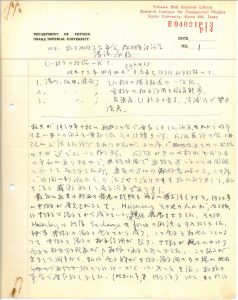Archive of historical materials

Lecture: On the Theory of the U-Particle
OU1938-B2 (8 pages) Date: April 4, 1938
Yukawa presented a general view on the U particle theory, which he had been working on together with Shoichi Sakata and Mitsuo Taketani, in the meeting, “Discussion on the Atomic Nucleus,” held by the Physical and Mathematical Society of Japan on April 4, in the Faculty of Science, Tokyo Imperial University. This manuscript was prepared by Yukawa for that review. In this report, Yukawa presented a general view on the background and current situation of the theory.
Since the neutron was discovered in 1932, Heisenberg formed an idea that the atomic nucleus could exist only because of the binding force of the protons and neutrons and the protons and neutrons were affected by their mutually changing interaction and that beta decay might be involved. Yukawa explained that he examined Heisenberg’s idea and then proposed the existence of the new particle (U particle) in 1934. Yukawa described that the U particle was a boson and it was a charged particle with the mass that was 200 times the mass of electron. He said what appeared to be the U particles were discovered during the observation of cosmic rays in then-recent years (from 1936 to 1937) and stressed the important of establishing a theory for the U particles.
Furthermore, Yukawa explained that the use of U particles for explaining the anomalous magnetic moments of protons and neutrons would require the investigation of the possibility of the U particle itself having a magnetic moment and that neutral V particles were necessary for the explanation of the forces between protons and between neutrons. Yukawa wrote down the equations that governed the U particles, V particles and heavy particles (proton P and neutron N) as well as their interactions. At that time, Yukawa et. al. were studying Proca’s paper written in French in 1936 in the laboratory in order to understand the vector field having that mass. From page 6, Yukawa wrote more detailed calculations. These calculations led to the result indicating that the energy was stabler when the spin of N-P is 1 than when the two heavy particles were in a spin-0 state. (Written by Yutaka Hosotani)


